Risk Management's Impact on Project Performance and Leadership
VerifiedAdded on 2022/09/09
|125
|30755
|20
Project
AI Summary
This project investigates the impact of risk management on project performance, mediated by leadership effectiveness, using Schenker Logistic (Malaysia) Sdn Bhd as a case study. The research addresses the problem of project failures, particularly in developing countries, and the importance of risk management in achieving project goals within time and budget constraints. The study explores key concepts, reviews relevant empirical research, and proposes a conceptual framework and hypotheses. The methodology includes a survey and data analysis to examine the relationships between risk management, leadership effectiveness, and project performance. The findings reveal the significance of risk management in enhancing project success, highlighting the role of leadership in mediating this impact. The project provides valuable insights for project managers and organizations seeking to improve project outcomes and mitigate risks.
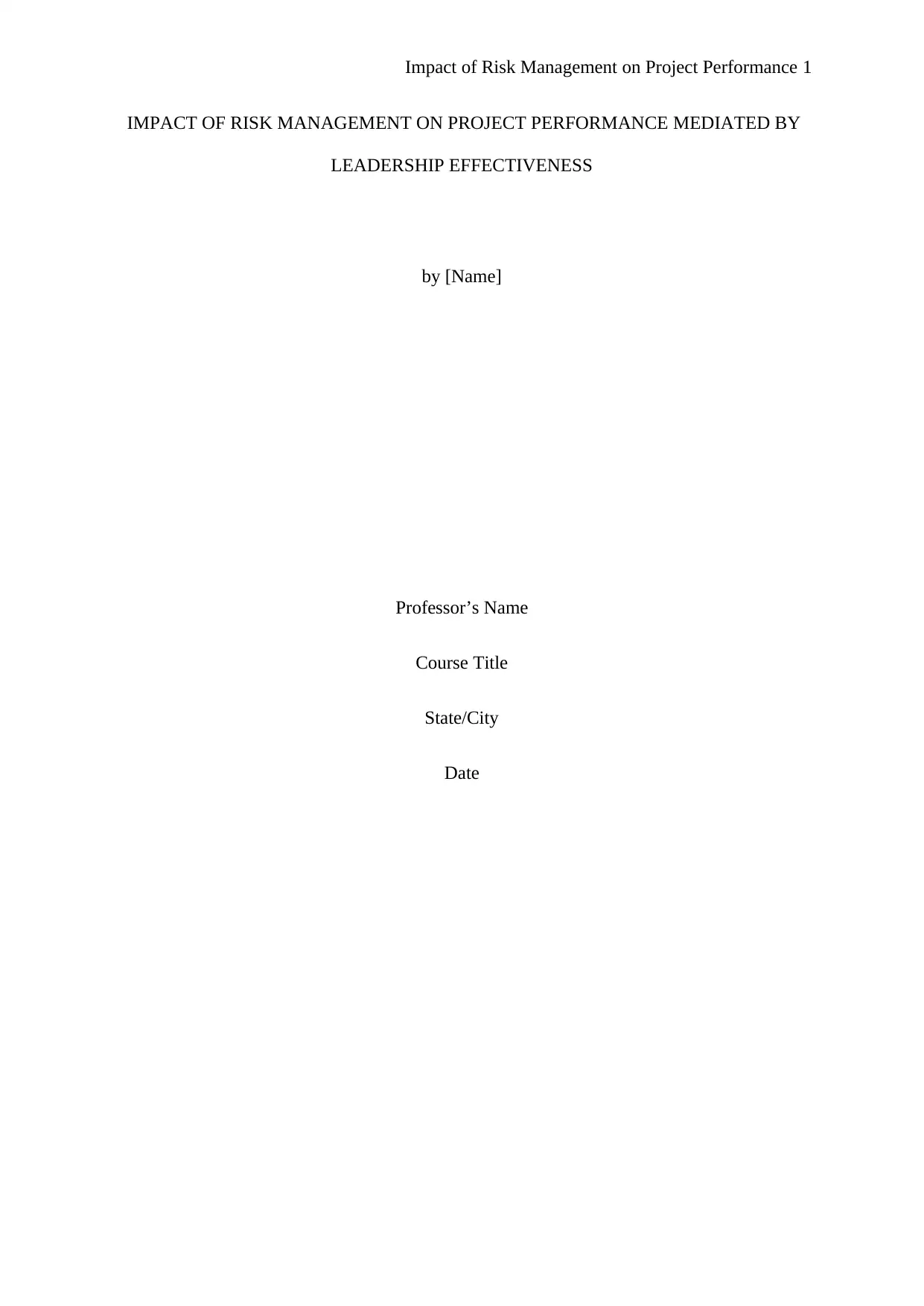
Impact of Risk Management on Project Performance 1
IMPACT OF RISK MANAGEMENT ON PROJECT PERFORMANCE MEDIATED BY
LEADERSHIP EFFECTIVENESS
by [Name]
Professor’s Name
Course Title
State/City
Date
IMPACT OF RISK MANAGEMENT ON PROJECT PERFORMANCE MEDIATED BY
LEADERSHIP EFFECTIVENESS
by [Name]
Professor’s Name
Course Title
State/City
Date
Paraphrase This Document
Need a fresh take? Get an instant paraphrase of this document with our AI Paraphraser
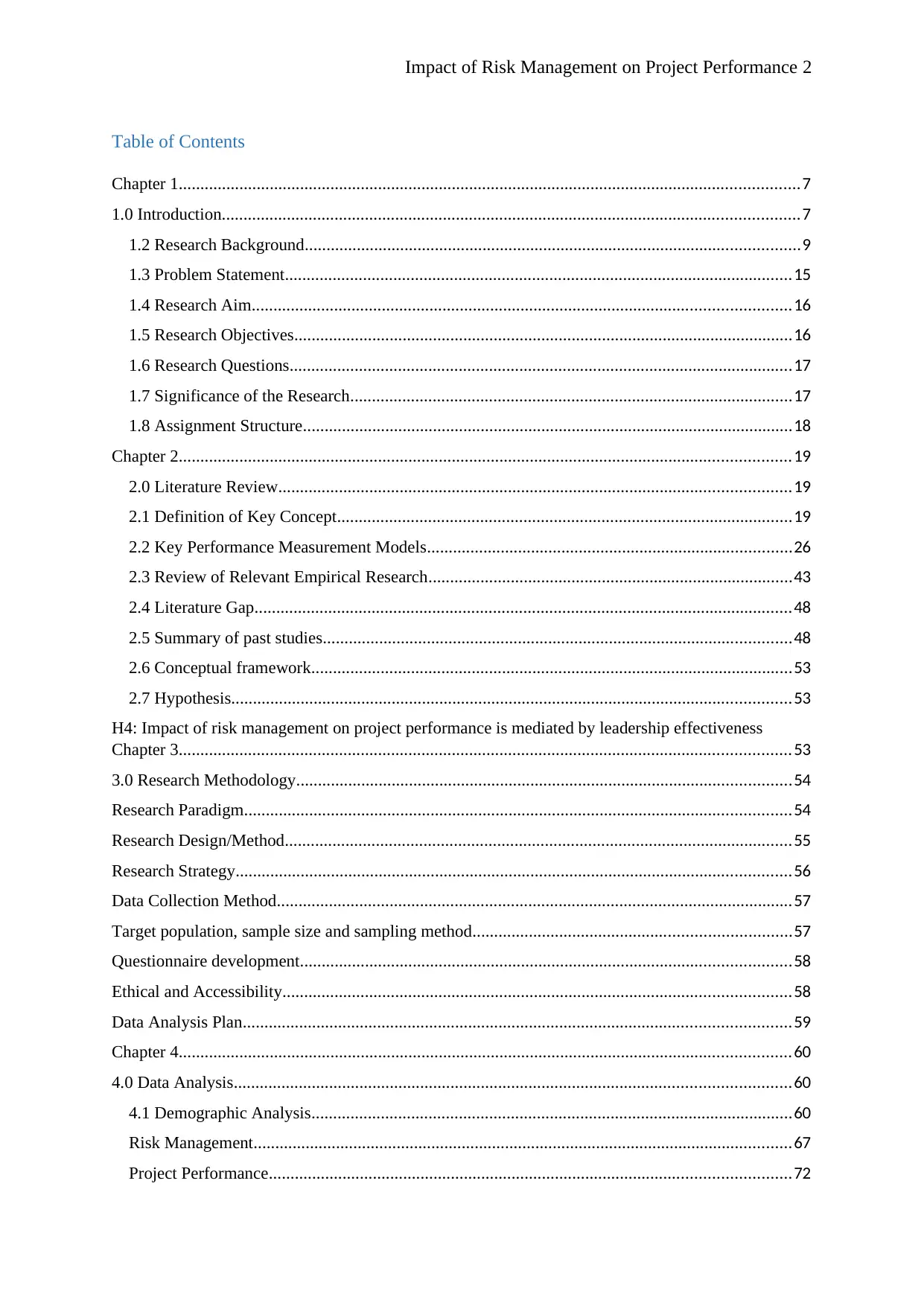
Impact of Risk Management on Project Performance 2
Table of Contents
Chapter 1...............................................................................................................................................7
1.0 Introduction.....................................................................................................................................7
1.2 Research Background..................................................................................................................9
1.3 Problem Statement.....................................................................................................................15
1.4 Research Aim............................................................................................................................16
1.5 Research Objectives...................................................................................................................16
1.6 Research Questions....................................................................................................................17
1.7 Significance of the Research......................................................................................................17
1.8 Assignment Structure.................................................................................................................18
Chapter 2.............................................................................................................................................19
2.0 Literature Review......................................................................................................................19
2.1 Definition of Key Concept.........................................................................................................19
2.2 Key Performance Measurement Models....................................................................................26
2.3 Review of Relevant Empirical Research....................................................................................43
2.4 Literature Gap............................................................................................................................48
2.5 Summary of past studies............................................................................................................48
2.6 Conceptual framework...............................................................................................................53
2.7 Hypothesis.................................................................................................................................53
H4: Impact of risk management on project performance is mediated by leadership effectiveness
Chapter 3.............................................................................................................................................53
3.0 Research Methodology..................................................................................................................54
Research Paradigm..............................................................................................................................54
Research Design/Method.....................................................................................................................55
Research Strategy................................................................................................................................56
Data Collection Method.......................................................................................................................57
Target population, sample size and sampling method.........................................................................57
Questionnaire development.................................................................................................................58
Ethical and Accessibility.....................................................................................................................58
Data Analysis Plan..............................................................................................................................59
Chapter 4.............................................................................................................................................60
4.0 Data Analysis................................................................................................................................60
4.1 Demographic Analysis...............................................................................................................60
Risk Management............................................................................................................................67
Project Performance........................................................................................................................72
Table of Contents
Chapter 1...............................................................................................................................................7
1.0 Introduction.....................................................................................................................................7
1.2 Research Background..................................................................................................................9
1.3 Problem Statement.....................................................................................................................15
1.4 Research Aim............................................................................................................................16
1.5 Research Objectives...................................................................................................................16
1.6 Research Questions....................................................................................................................17
1.7 Significance of the Research......................................................................................................17
1.8 Assignment Structure.................................................................................................................18
Chapter 2.............................................................................................................................................19
2.0 Literature Review......................................................................................................................19
2.1 Definition of Key Concept.........................................................................................................19
2.2 Key Performance Measurement Models....................................................................................26
2.3 Review of Relevant Empirical Research....................................................................................43
2.4 Literature Gap............................................................................................................................48
2.5 Summary of past studies............................................................................................................48
2.6 Conceptual framework...............................................................................................................53
2.7 Hypothesis.................................................................................................................................53
H4: Impact of risk management on project performance is mediated by leadership effectiveness
Chapter 3.............................................................................................................................................53
3.0 Research Methodology..................................................................................................................54
Research Paradigm..............................................................................................................................54
Research Design/Method.....................................................................................................................55
Research Strategy................................................................................................................................56
Data Collection Method.......................................................................................................................57
Target population, sample size and sampling method.........................................................................57
Questionnaire development.................................................................................................................58
Ethical and Accessibility.....................................................................................................................58
Data Analysis Plan..............................................................................................................................59
Chapter 4.............................................................................................................................................60
4.0 Data Analysis................................................................................................................................60
4.1 Demographic Analysis...............................................................................................................60
Risk Management............................................................................................................................67
Project Performance........................................................................................................................72
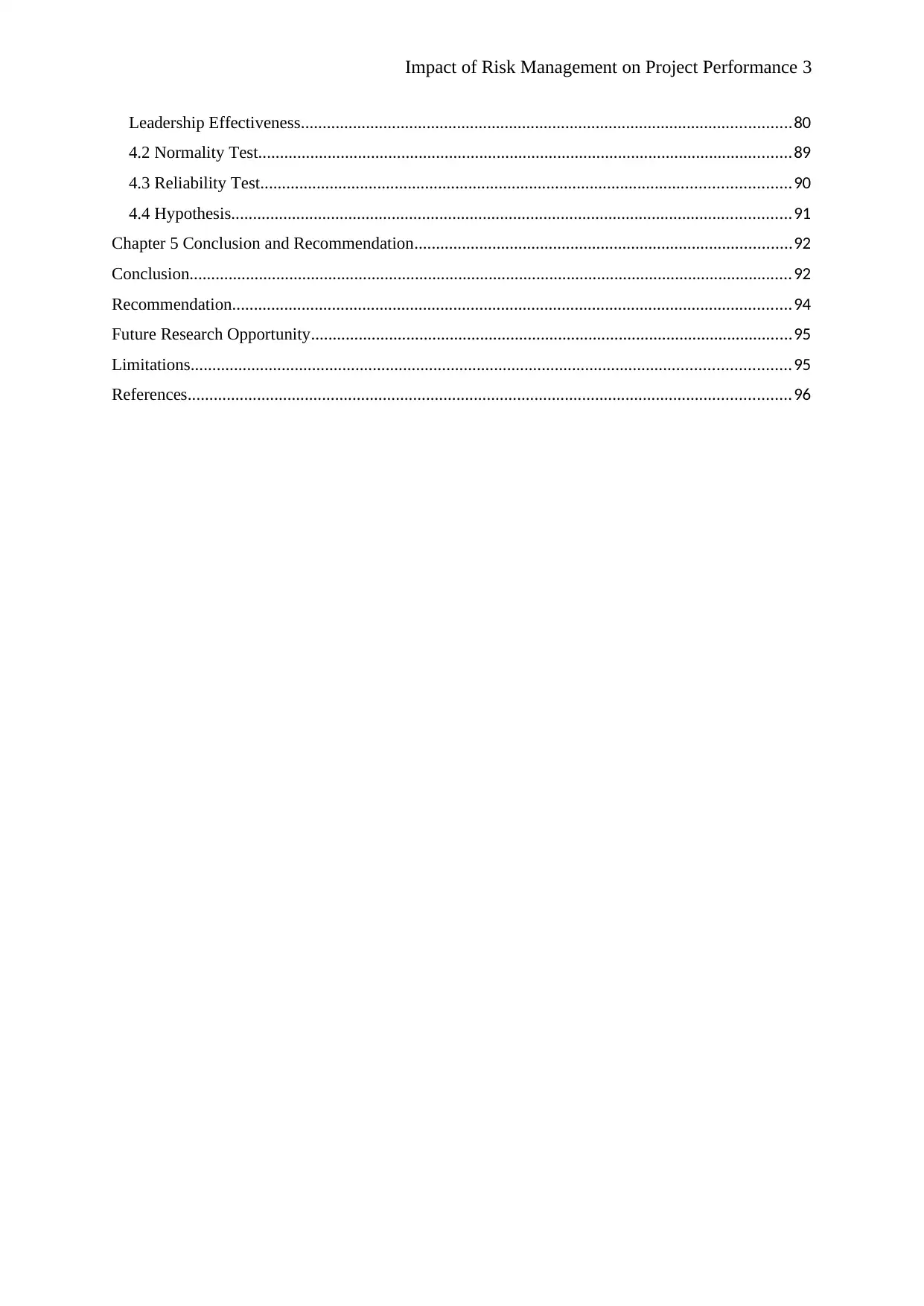
Impact of Risk Management on Project Performance 3
Leadership Effectiveness.................................................................................................................80
4.2 Normality Test...........................................................................................................................89
4.3 Reliability Test..........................................................................................................................90
4.4 Hypothesis.................................................................................................................................91
Chapter 5 Conclusion and Recommendation.......................................................................................92
Conclusion...........................................................................................................................................92
Recommendation.................................................................................................................................94
Future Research Opportunity...............................................................................................................95
Limitations..........................................................................................................................................95
References...........................................................................................................................................96
Leadership Effectiveness.................................................................................................................80
4.2 Normality Test...........................................................................................................................89
4.3 Reliability Test..........................................................................................................................90
4.4 Hypothesis.................................................................................................................................91
Chapter 5 Conclusion and Recommendation.......................................................................................92
Conclusion...........................................................................................................................................92
Recommendation.................................................................................................................................94
Future Research Opportunity...............................................................................................................95
Limitations..........................................................................................................................................95
References...........................................................................................................................................96
⊘ This is a preview!⊘
Do you want full access?
Subscribe today to unlock all pages.

Trusted by 1+ million students worldwide
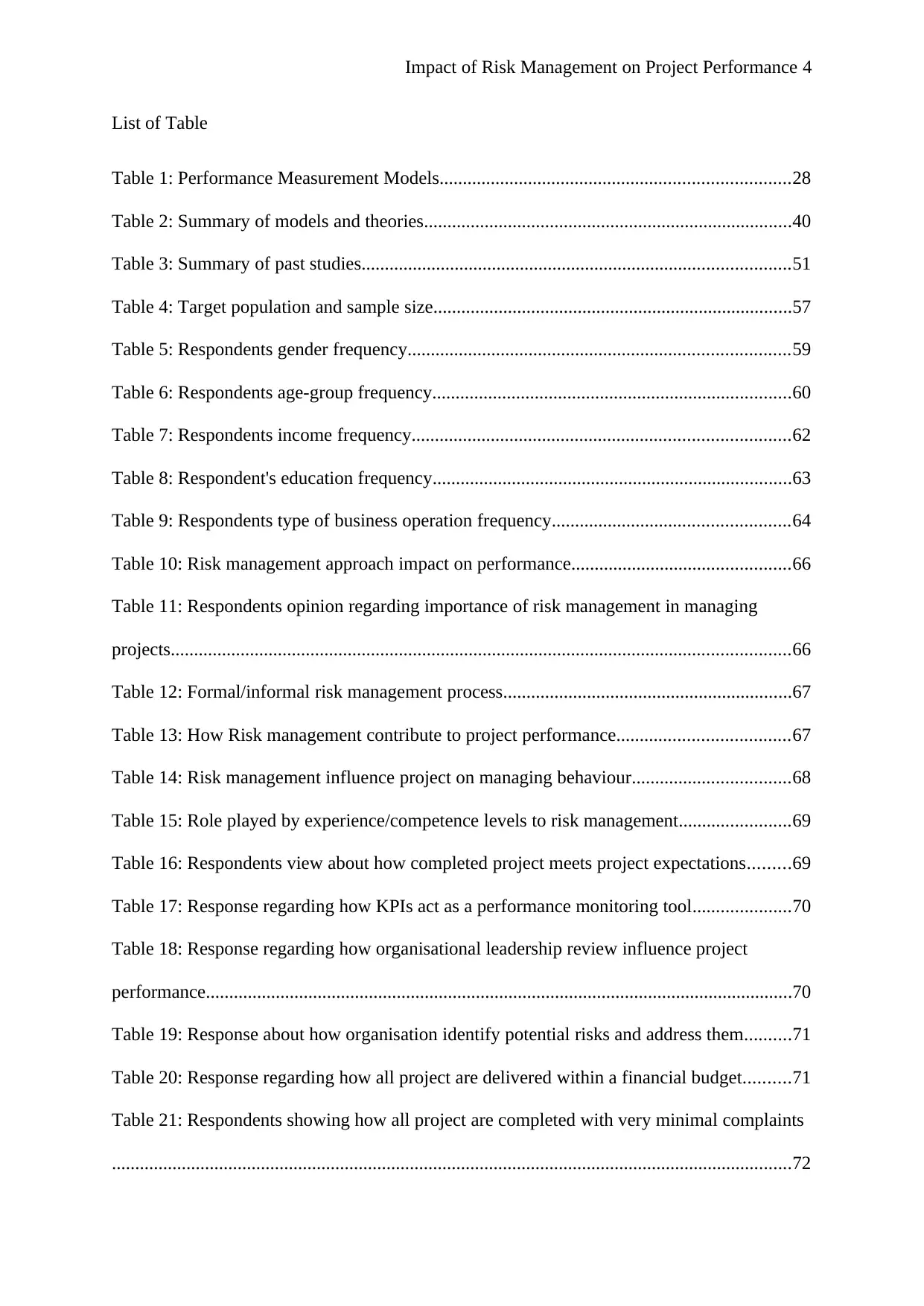
Impact of Risk Management on Project Performance 4
List of Table
Table 1: Performance Measurement Models...........................................................................28
Table 2: Summary of models and theories...............................................................................40
Table 3: Summary of past studies............................................................................................51
Table 4: Target population and sample size.............................................................................57
Table 5: Respondents gender frequency..................................................................................59
Table 6: Respondents age-group frequency.............................................................................60
Table 7: Respondents income frequency.................................................................................62
Table 8: Respondent's education frequency.............................................................................63
Table 9: Respondents type of business operation frequency...................................................64
Table 10: Risk management approach impact on performance...............................................66
Table 11: Respondents opinion regarding importance of risk management in managing
projects.....................................................................................................................................66
Table 12: Formal/informal risk management process..............................................................67
Table 13: How Risk management contribute to project performance.....................................67
Table 14: Risk management influence project on managing behaviour..................................68
Table 15: Role played by experience/competence levels to risk management........................69
Table 16: Respondents view about how completed project meets project expectations.........69
Table 17: Response regarding how KPIs act as a performance monitoring tool.....................70
Table 18: Response regarding how organisational leadership review influence project
performance..............................................................................................................................70
Table 19: Response about how organisation identify potential risks and address them..........71
Table 20: Response regarding how all project are delivered within a financial budget..........71
Table 21: Respondents showing how all project are completed with very minimal complaints
..................................................................................................................................................72
List of Table
Table 1: Performance Measurement Models...........................................................................28
Table 2: Summary of models and theories...............................................................................40
Table 3: Summary of past studies............................................................................................51
Table 4: Target population and sample size.............................................................................57
Table 5: Respondents gender frequency..................................................................................59
Table 6: Respondents age-group frequency.............................................................................60
Table 7: Respondents income frequency.................................................................................62
Table 8: Respondent's education frequency.............................................................................63
Table 9: Respondents type of business operation frequency...................................................64
Table 10: Risk management approach impact on performance...............................................66
Table 11: Respondents opinion regarding importance of risk management in managing
projects.....................................................................................................................................66
Table 12: Formal/informal risk management process..............................................................67
Table 13: How Risk management contribute to project performance.....................................67
Table 14: Risk management influence project on managing behaviour..................................68
Table 15: Role played by experience/competence levels to risk management........................69
Table 16: Respondents view about how completed project meets project expectations.........69
Table 17: Response regarding how KPIs act as a performance monitoring tool.....................70
Table 18: Response regarding how organisational leadership review influence project
performance..............................................................................................................................70
Table 19: Response about how organisation identify potential risks and address them..........71
Table 20: Response regarding how all project are delivered within a financial budget..........71
Table 21: Respondents showing how all project are completed with very minimal complaints
..................................................................................................................................................72
Paraphrase This Document
Need a fresh take? Get an instant paraphrase of this document with our AI Paraphraser
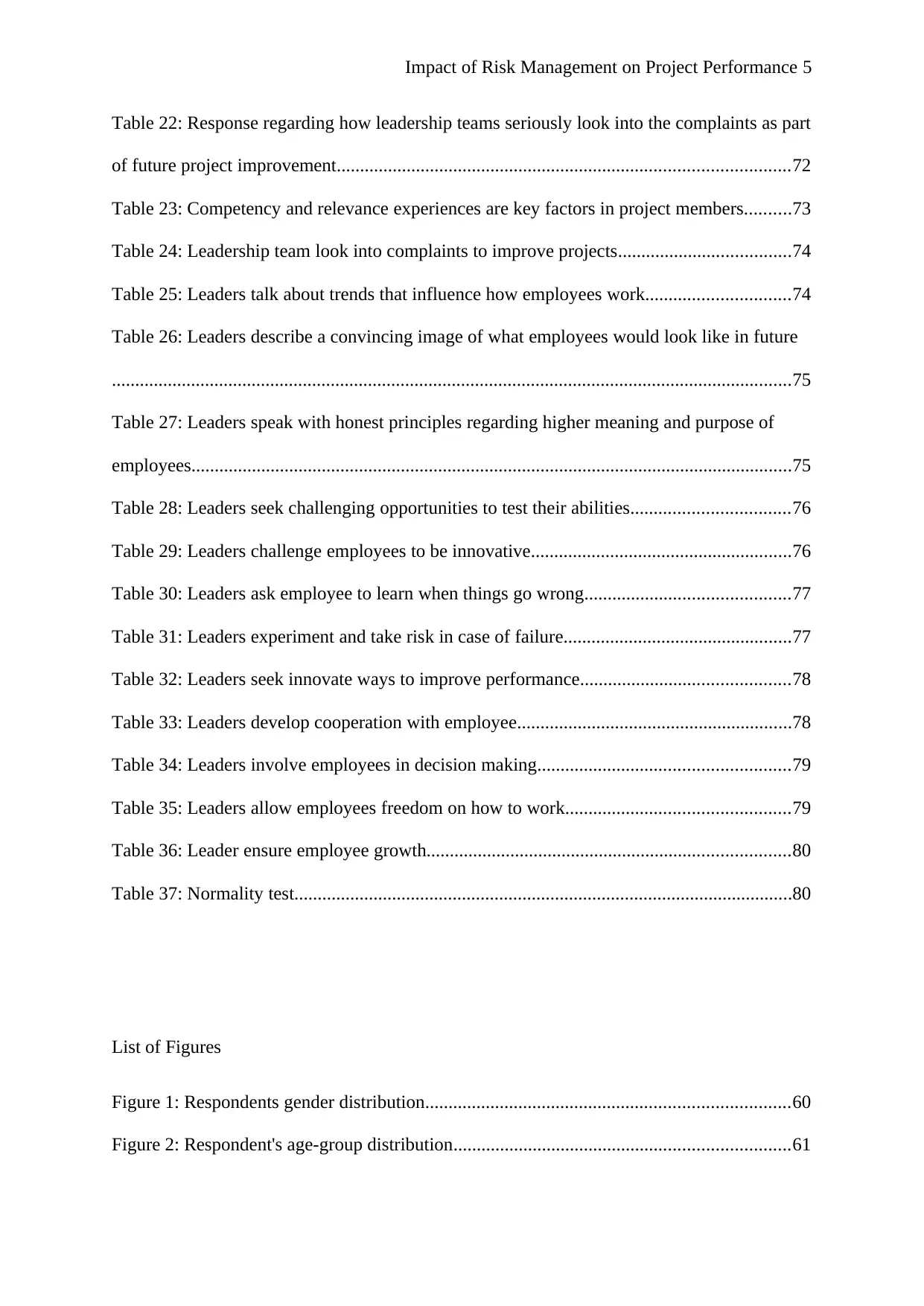
Impact of Risk Management on Project Performance 5
Table 22: Response regarding how leadership teams seriously look into the complaints as part
of future project improvement.................................................................................................72
Table 23: Competency and relevance experiences are key factors in project members..........73
Table 24: Leadership team look into complaints to improve projects.....................................74
Table 25: Leaders talk about trends that influence how employees work...............................74
Table 26: Leaders describe a convincing image of what employees would look like in future
..................................................................................................................................................75
Table 27: Leaders speak with honest principles regarding higher meaning and purpose of
employees.................................................................................................................................75
Table 28: Leaders seek challenging opportunities to test their abilities..................................76
Table 29: Leaders challenge employees to be innovative........................................................76
Table 30: Leaders ask employee to learn when things go wrong............................................77
Table 31: Leaders experiment and take risk in case of failure.................................................77
Table 32: Leaders seek innovate ways to improve performance.............................................78
Table 33: Leaders develop cooperation with employee...........................................................78
Table 34: Leaders involve employees in decision making......................................................79
Table 35: Leaders allow employees freedom on how to work................................................79
Table 36: Leader ensure employee growth..............................................................................80
Table 37: Normality test...........................................................................................................80
List of Figures
Figure 1: Respondents gender distribution..............................................................................60
Figure 2: Respondent's age-group distribution........................................................................61
Table 22: Response regarding how leadership teams seriously look into the complaints as part
of future project improvement.................................................................................................72
Table 23: Competency and relevance experiences are key factors in project members..........73
Table 24: Leadership team look into complaints to improve projects.....................................74
Table 25: Leaders talk about trends that influence how employees work...............................74
Table 26: Leaders describe a convincing image of what employees would look like in future
..................................................................................................................................................75
Table 27: Leaders speak with honest principles regarding higher meaning and purpose of
employees.................................................................................................................................75
Table 28: Leaders seek challenging opportunities to test their abilities..................................76
Table 29: Leaders challenge employees to be innovative........................................................76
Table 30: Leaders ask employee to learn when things go wrong............................................77
Table 31: Leaders experiment and take risk in case of failure.................................................77
Table 32: Leaders seek innovate ways to improve performance.............................................78
Table 33: Leaders develop cooperation with employee...........................................................78
Table 34: Leaders involve employees in decision making......................................................79
Table 35: Leaders allow employees freedom on how to work................................................79
Table 36: Leader ensure employee growth..............................................................................80
Table 37: Normality test...........................................................................................................80
List of Figures
Figure 1: Respondents gender distribution..............................................................................60
Figure 2: Respondent's age-group distribution........................................................................61
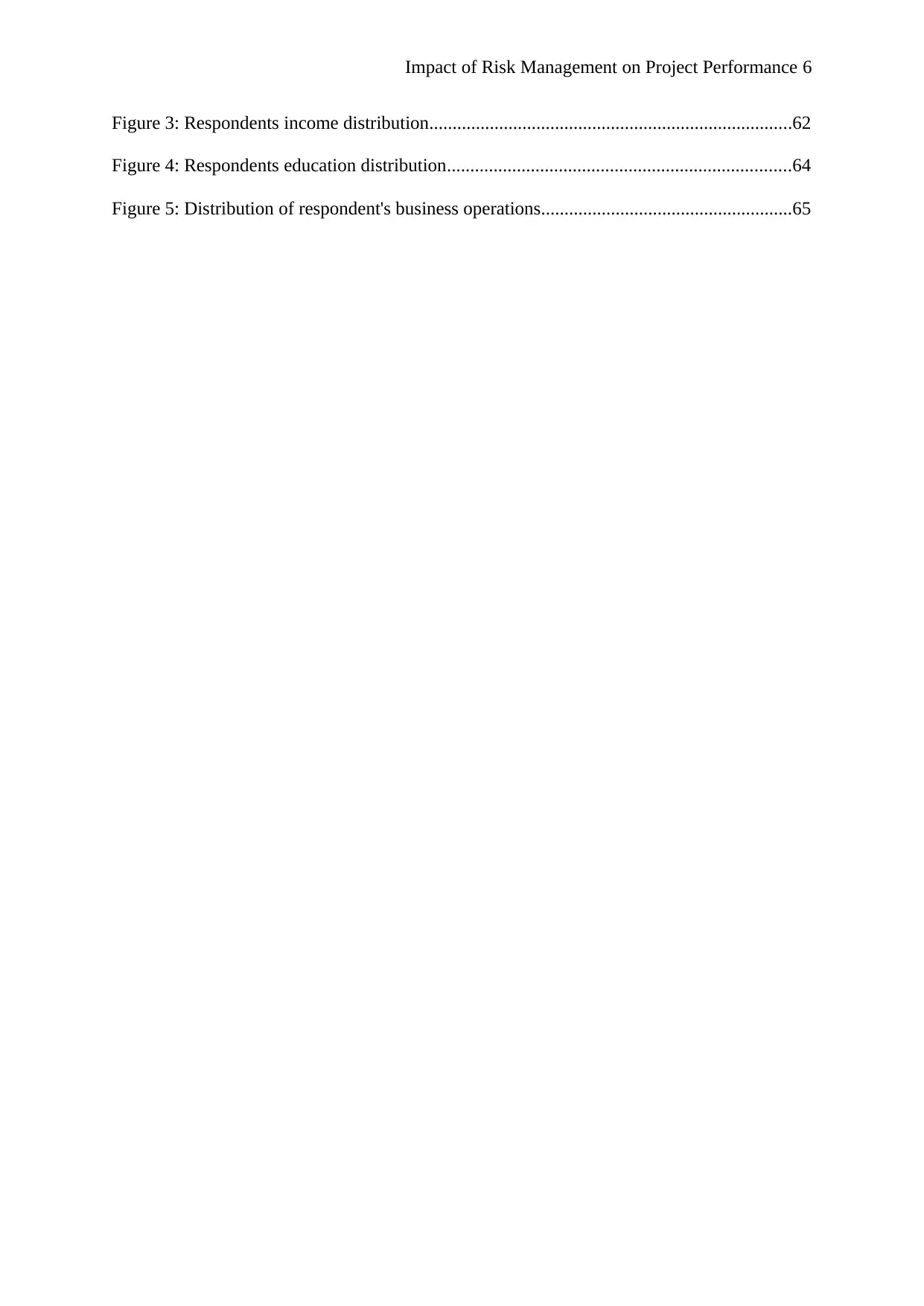
Impact of Risk Management on Project Performance 6
Figure 3: Respondents income distribution..............................................................................62
Figure 4: Respondents education distribution..........................................................................64
Figure 5: Distribution of respondent's business operations......................................................65
Figure 3: Respondents income distribution..............................................................................62
Figure 4: Respondents education distribution..........................................................................64
Figure 5: Distribution of respondent's business operations......................................................65
⊘ This is a preview!⊘
Do you want full access?
Subscribe today to unlock all pages.

Trusted by 1+ million students worldwide
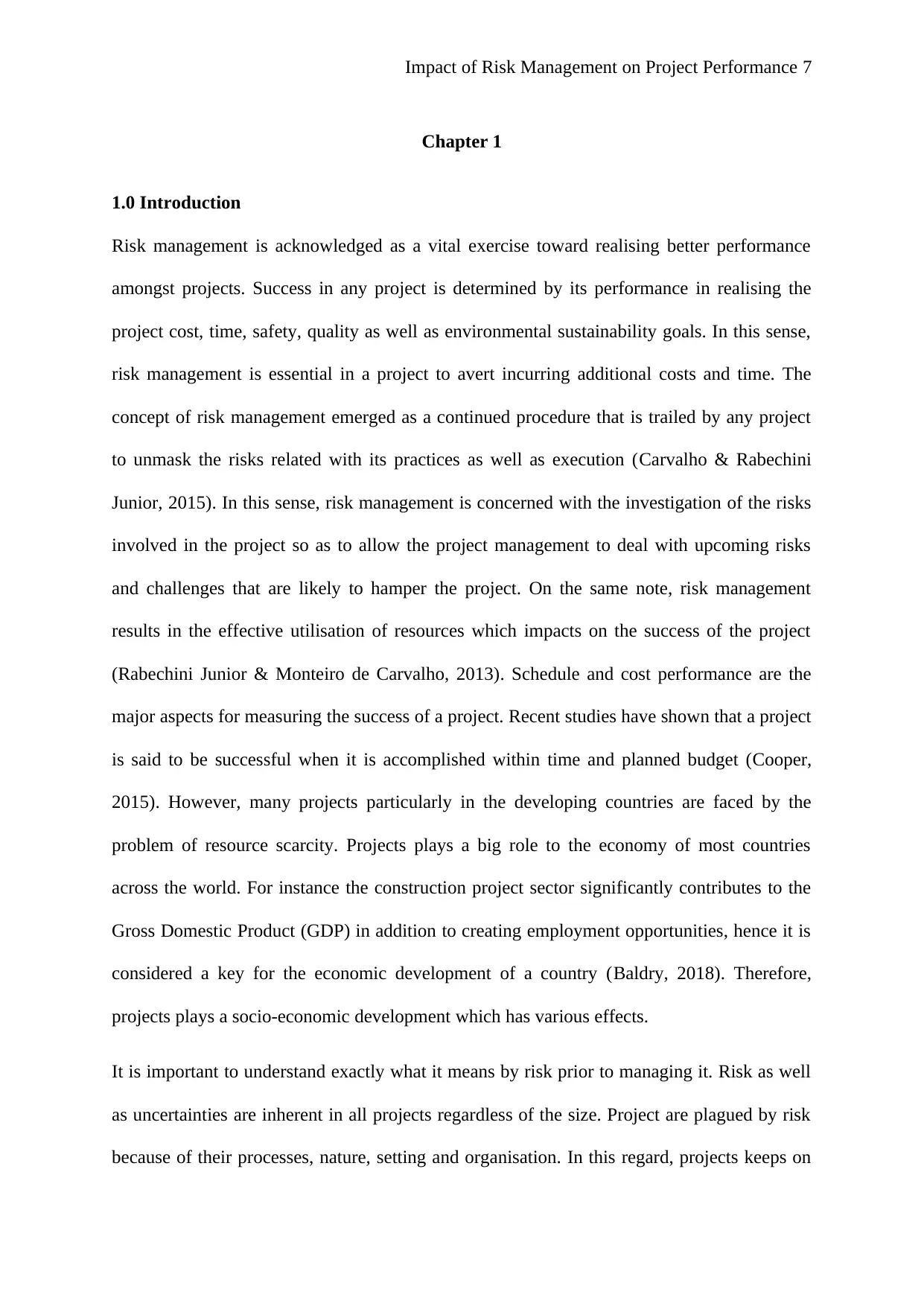
Impact of Risk Management on Project Performance 7
Chapter 1
1.0 Introduction
Risk management is acknowledged as a vital exercise toward realising better performance
amongst projects. Success in any project is determined by its performance in realising the
project cost, time, safety, quality as well as environmental sustainability goals. In this sense,
risk management is essential in a project to avert incurring additional costs and time. The
concept of risk management emerged as a continued procedure that is trailed by any project
to unmask the risks related with its practices as well as execution (Carvalho & Rabechini
Junior, 2015). In this sense, risk management is concerned with the investigation of the risks
involved in the project so as to allow the project management to deal with upcoming risks
and challenges that are likely to hamper the project. On the same note, risk management
results in the effective utilisation of resources which impacts on the success of the project
(Rabechini Junior & Monteiro de Carvalho, 2013). Schedule and cost performance are the
major aspects for measuring the success of a project. Recent studies have shown that a project
is said to be successful when it is accomplished within time and planned budget (Cooper,
2015). However, many projects particularly in the developing countries are faced by the
problem of resource scarcity. Projects plays a big role to the economy of most countries
across the world. For instance the construction project sector significantly contributes to the
Gross Domestic Product (GDP) in addition to creating employment opportunities, hence it is
considered a key for the economic development of a country (Baldry, 2018). Therefore,
projects plays a socio-economic development which has various effects.
It is important to understand exactly what it means by risk prior to managing it. Risk as well
as uncertainties are inherent in all projects regardless of the size. Project are plagued by risk
because of their processes, nature, setting and organisation. In this regard, projects keeps on
Chapter 1
1.0 Introduction
Risk management is acknowledged as a vital exercise toward realising better performance
amongst projects. Success in any project is determined by its performance in realising the
project cost, time, safety, quality as well as environmental sustainability goals. In this sense,
risk management is essential in a project to avert incurring additional costs and time. The
concept of risk management emerged as a continued procedure that is trailed by any project
to unmask the risks related with its practices as well as execution (Carvalho & Rabechini
Junior, 2015). In this sense, risk management is concerned with the investigation of the risks
involved in the project so as to allow the project management to deal with upcoming risks
and challenges that are likely to hamper the project. On the same note, risk management
results in the effective utilisation of resources which impacts on the success of the project
(Rabechini Junior & Monteiro de Carvalho, 2013). Schedule and cost performance are the
major aspects for measuring the success of a project. Recent studies have shown that a project
is said to be successful when it is accomplished within time and planned budget (Cooper,
2015). However, many projects particularly in the developing countries are faced by the
problem of resource scarcity. Projects plays a big role to the economy of most countries
across the world. For instance the construction project sector significantly contributes to the
Gross Domestic Product (GDP) in addition to creating employment opportunities, hence it is
considered a key for the economic development of a country (Baldry, 2018). Therefore,
projects plays a socio-economic development which has various effects.
It is important to understand exactly what it means by risk prior to managing it. Risk as well
as uncertainties are inherent in all projects regardless of the size. Project are plagued by risk
because of their processes, nature, setting and organisation. In this regard, projects keeps on
Paraphrase This Document
Need a fresh take? Get an instant paraphrase of this document with our AI Paraphraser
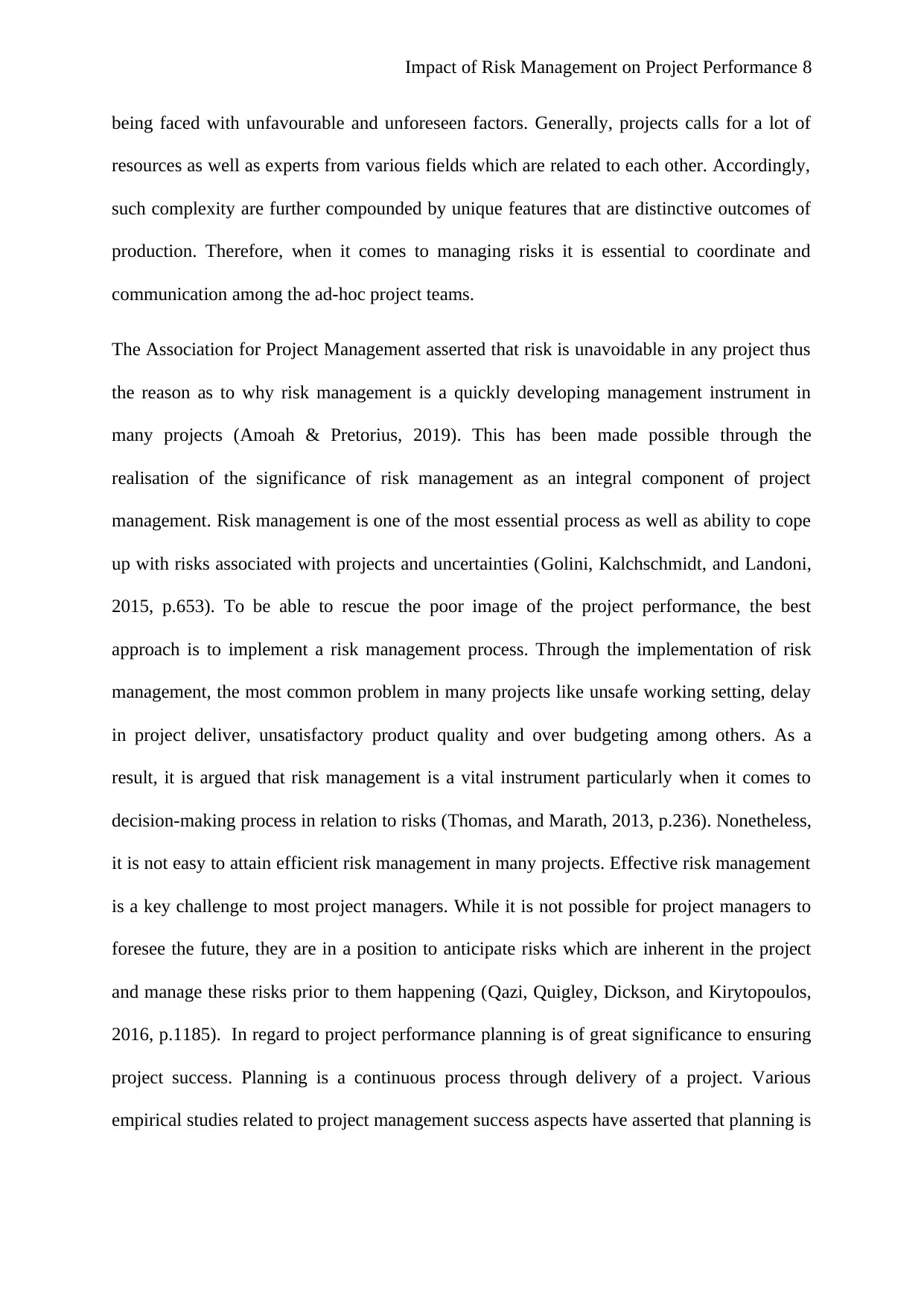
Impact of Risk Management on Project Performance 8
being faced with unfavourable and unforeseen factors. Generally, projects calls for a lot of
resources as well as experts from various fields which are related to each other. Accordingly,
such complexity are further compounded by unique features that are distinctive outcomes of
production. Therefore, when it comes to managing risks it is essential to coordinate and
communication among the ad-hoc project teams.
The Association for Project Management asserted that risk is unavoidable in any project thus
the reason as to why risk management is a quickly developing management instrument in
many projects (Amoah & Pretorius, 2019). This has been made possible through the
realisation of the significance of risk management as an integral component of project
management. Risk management is one of the most essential process as well as ability to cope
up with risks associated with projects and uncertainties (Golini, Kalchschmidt, and Landoni,
2015, p.653). To be able to rescue the poor image of the project performance, the best
approach is to implement a risk management process. Through the implementation of risk
management, the most common problem in many projects like unsafe working setting, delay
in project deliver, unsatisfactory product quality and over budgeting among others. As a
result, it is argued that risk management is a vital instrument particularly when it comes to
decision-making process in relation to risks (Thomas, and Marath, 2013, p.236). Nonetheless,
it is not easy to attain efficient risk management in many projects. Effective risk management
is a key challenge to most project managers. While it is not possible for project managers to
foresee the future, they are in a position to anticipate risks which are inherent in the project
and manage these risks prior to them happening (Qazi, Quigley, Dickson, and Kirytopoulos,
2016, p.1185). In regard to project performance planning is of great significance to ensuring
project success. Planning is a continuous process through delivery of a project. Various
empirical studies related to project management success aspects have asserted that planning is
being faced with unfavourable and unforeseen factors. Generally, projects calls for a lot of
resources as well as experts from various fields which are related to each other. Accordingly,
such complexity are further compounded by unique features that are distinctive outcomes of
production. Therefore, when it comes to managing risks it is essential to coordinate and
communication among the ad-hoc project teams.
The Association for Project Management asserted that risk is unavoidable in any project thus
the reason as to why risk management is a quickly developing management instrument in
many projects (Amoah & Pretorius, 2019). This has been made possible through the
realisation of the significance of risk management as an integral component of project
management. Risk management is one of the most essential process as well as ability to cope
up with risks associated with projects and uncertainties (Golini, Kalchschmidt, and Landoni,
2015, p.653). To be able to rescue the poor image of the project performance, the best
approach is to implement a risk management process. Through the implementation of risk
management, the most common problem in many projects like unsafe working setting, delay
in project deliver, unsatisfactory product quality and over budgeting among others. As a
result, it is argued that risk management is a vital instrument particularly when it comes to
decision-making process in relation to risks (Thomas, and Marath, 2013, p.236). Nonetheless,
it is not easy to attain efficient risk management in many projects. Effective risk management
is a key challenge to most project managers. While it is not possible for project managers to
foresee the future, they are in a position to anticipate risks which are inherent in the project
and manage these risks prior to them happening (Qazi, Quigley, Dickson, and Kirytopoulos,
2016, p.1185). In regard to project performance planning is of great significance to ensuring
project success. Planning is a continuous process through delivery of a project. Various
empirical studies related to project management success aspects have asserted that planning is
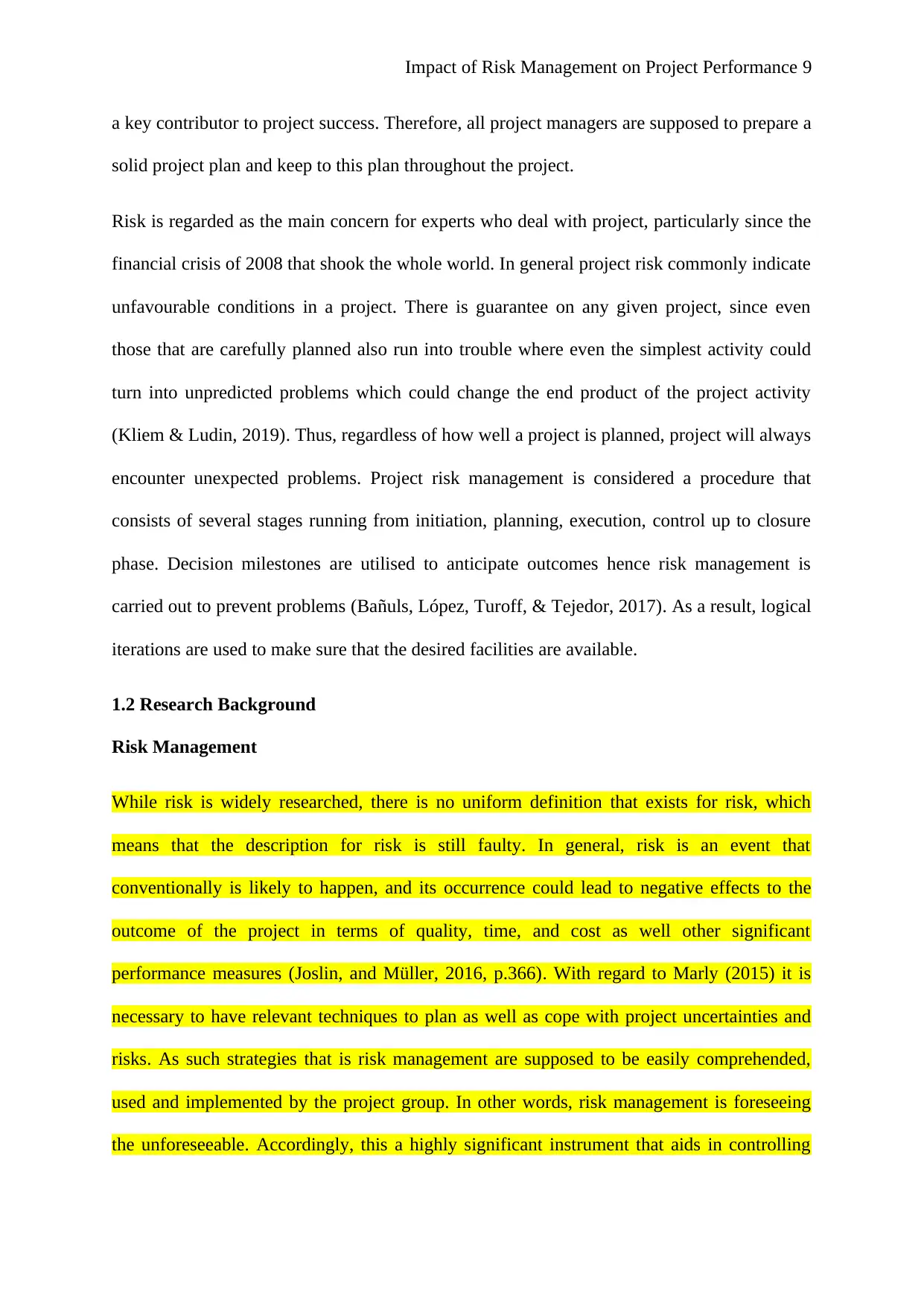
Impact of Risk Management on Project Performance 9
a key contributor to project success. Therefore, all project managers are supposed to prepare a
solid project plan and keep to this plan throughout the project.
Risk is regarded as the main concern for experts who deal with project, particularly since the
financial crisis of 2008 that shook the whole world. In general project risk commonly indicate
unfavourable conditions in a project. There is guarantee on any given project, since even
those that are carefully planned also run into trouble where even the simplest activity could
turn into unpredicted problems which could change the end product of the project activity
(Kliem & Ludin, 2019). Thus, regardless of how well a project is planned, project will always
encounter unexpected problems. Project risk management is considered a procedure that
consists of several stages running from initiation, planning, execution, control up to closure
phase. Decision milestones are utilised to anticipate outcomes hence risk management is
carried out to prevent problems (Bañuls, López, Turoff, & Tejedor, 2017). As a result, logical
iterations are used to make sure that the desired facilities are available.
1.2 Research Background
Risk Management
While risk is widely researched, there is no uniform definition that exists for risk, which
means that the description for risk is still faulty. In general, risk is an event that
conventionally is likely to happen, and its occurrence could lead to negative effects to the
outcome of the project in terms of quality, time, and cost as well other significant
performance measures (Joslin, and Müller, 2016, p.366). With regard to Marly (2015) it is
necessary to have relevant techniques to plan as well as cope with project uncertainties and
risks. As such strategies that is risk management are supposed to be easily comprehended,
used and implemented by the project group. In other words, risk management is foreseeing
the unforeseeable. Accordingly, this a highly significant instrument that aids in controlling
a key contributor to project success. Therefore, all project managers are supposed to prepare a
solid project plan and keep to this plan throughout the project.
Risk is regarded as the main concern for experts who deal with project, particularly since the
financial crisis of 2008 that shook the whole world. In general project risk commonly indicate
unfavourable conditions in a project. There is guarantee on any given project, since even
those that are carefully planned also run into trouble where even the simplest activity could
turn into unpredicted problems which could change the end product of the project activity
(Kliem & Ludin, 2019). Thus, regardless of how well a project is planned, project will always
encounter unexpected problems. Project risk management is considered a procedure that
consists of several stages running from initiation, planning, execution, control up to closure
phase. Decision milestones are utilised to anticipate outcomes hence risk management is
carried out to prevent problems (Bañuls, López, Turoff, & Tejedor, 2017). As a result, logical
iterations are used to make sure that the desired facilities are available.
1.2 Research Background
Risk Management
While risk is widely researched, there is no uniform definition that exists for risk, which
means that the description for risk is still faulty. In general, risk is an event that
conventionally is likely to happen, and its occurrence could lead to negative effects to the
outcome of the project in terms of quality, time, and cost as well other significant
performance measures (Joslin, and Müller, 2016, p.366). With regard to Marly (2015) it is
necessary to have relevant techniques to plan as well as cope with project uncertainties and
risks. As such strategies that is risk management are supposed to be easily comprehended,
used and implemented by the project group. In other words, risk management is foreseeing
the unforeseeable. Accordingly, this a highly significant instrument that aids in controlling
⊘ This is a preview!⊘
Do you want full access?
Subscribe today to unlock all pages.

Trusted by 1+ million students worldwide
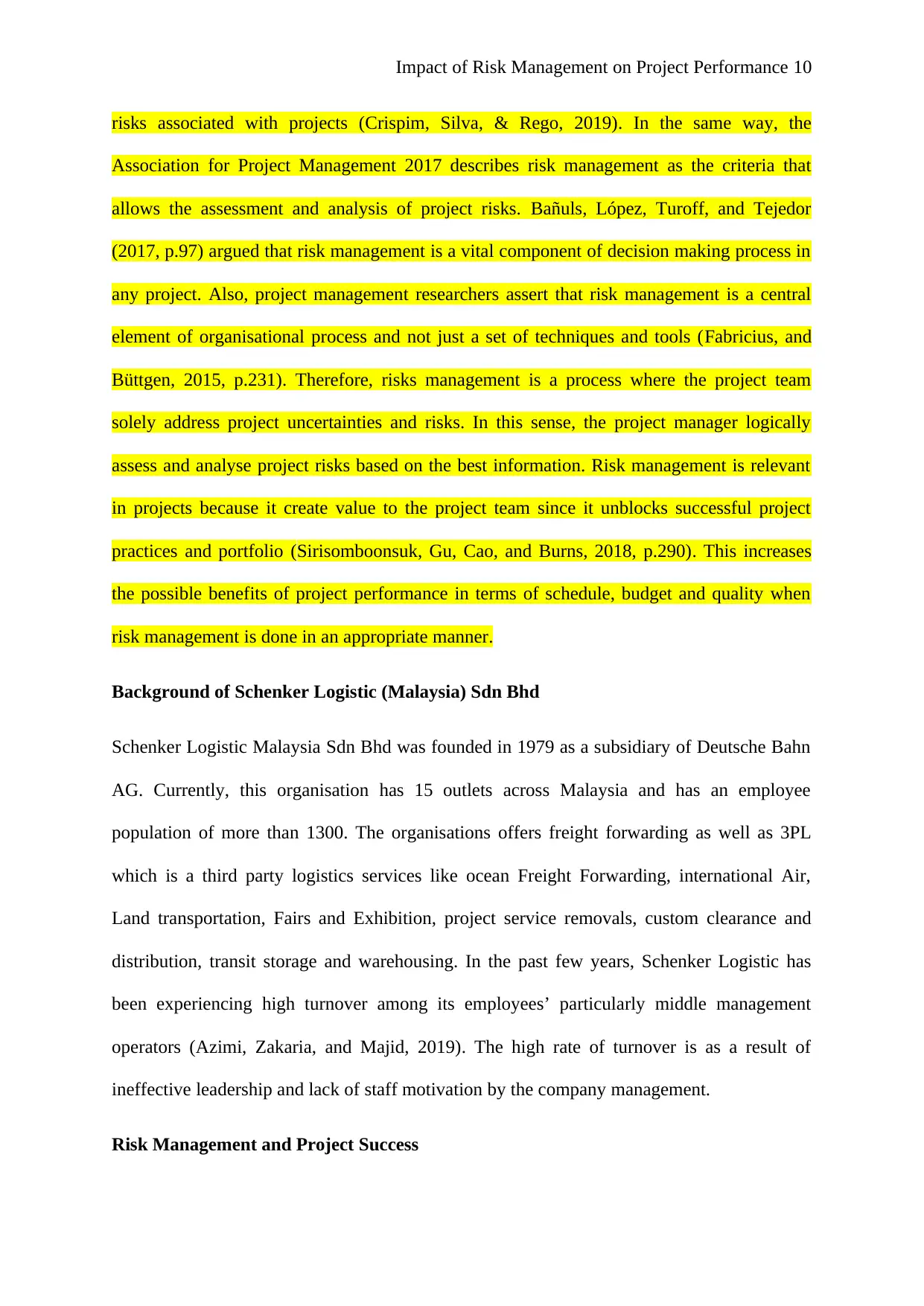
Impact of Risk Management on Project Performance 10
risks associated with projects (Crispim, Silva, & Rego, 2019). In the same way, the
Association for Project Management 2017 describes risk management as the criteria that
allows the assessment and analysis of project risks. Bañuls, López, Turoff, and Tejedor
(2017, p.97) argued that risk management is a vital component of decision making process in
any project. Also, project management researchers assert that risk management is a central
element of organisational process and not just a set of techniques and tools (Fabricius, and
Büttgen, 2015, p.231). Therefore, risks management is a process where the project team
solely address project uncertainties and risks. In this sense, the project manager logically
assess and analyse project risks based on the best information. Risk management is relevant
in projects because it create value to the project team since it unblocks successful project
practices and portfolio (Sirisomboonsuk, Gu, Cao, and Burns, 2018, p.290). This increases
the possible benefits of project performance in terms of schedule, budget and quality when
risk management is done in an appropriate manner.
Background of Schenker Logistic (Malaysia) Sdn Bhd
Schenker Logistic Malaysia Sdn Bhd was founded in 1979 as a subsidiary of Deutsche Bahn
AG. Currently, this organisation has 15 outlets across Malaysia and has an employee
population of more than 1300. The organisations offers freight forwarding as well as 3PL
which is a third party logistics services like ocean Freight Forwarding, international Air,
Land transportation, Fairs and Exhibition, project service removals, custom clearance and
distribution, transit storage and warehousing. In the past few years, Schenker Logistic has
been experiencing high turnover among its employees’ particularly middle management
operators (Azimi, Zakaria, and Majid, 2019). The high rate of turnover is as a result of
ineffective leadership and lack of staff motivation by the company management.
Risk Management and Project Success
risks associated with projects (Crispim, Silva, & Rego, 2019). In the same way, the
Association for Project Management 2017 describes risk management as the criteria that
allows the assessment and analysis of project risks. Bañuls, López, Turoff, and Tejedor
(2017, p.97) argued that risk management is a vital component of decision making process in
any project. Also, project management researchers assert that risk management is a central
element of organisational process and not just a set of techniques and tools (Fabricius, and
Büttgen, 2015, p.231). Therefore, risks management is a process where the project team
solely address project uncertainties and risks. In this sense, the project manager logically
assess and analyse project risks based on the best information. Risk management is relevant
in projects because it create value to the project team since it unblocks successful project
practices and portfolio (Sirisomboonsuk, Gu, Cao, and Burns, 2018, p.290). This increases
the possible benefits of project performance in terms of schedule, budget and quality when
risk management is done in an appropriate manner.
Background of Schenker Logistic (Malaysia) Sdn Bhd
Schenker Logistic Malaysia Sdn Bhd was founded in 1979 as a subsidiary of Deutsche Bahn
AG. Currently, this organisation has 15 outlets across Malaysia and has an employee
population of more than 1300. The organisations offers freight forwarding as well as 3PL
which is a third party logistics services like ocean Freight Forwarding, international Air,
Land transportation, Fairs and Exhibition, project service removals, custom clearance and
distribution, transit storage and warehousing. In the past few years, Schenker Logistic has
been experiencing high turnover among its employees’ particularly middle management
operators (Azimi, Zakaria, and Majid, 2019). The high rate of turnover is as a result of
ineffective leadership and lack of staff motivation by the company management.
Risk Management and Project Success
Paraphrase This Document
Need a fresh take? Get an instant paraphrase of this document with our AI Paraphraser
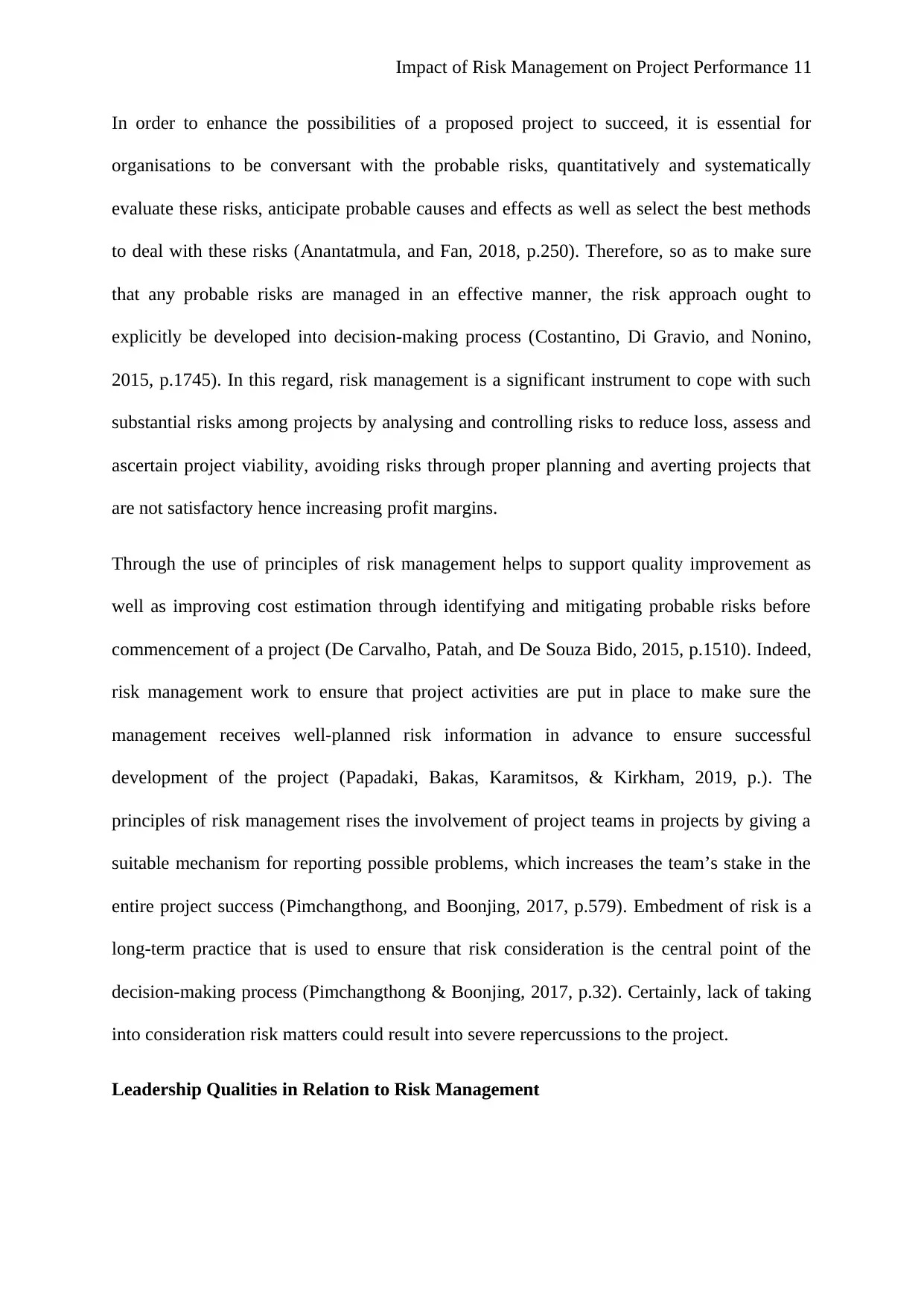
Impact of Risk Management on Project Performance 11
In order to enhance the possibilities of a proposed project to succeed, it is essential for
organisations to be conversant with the probable risks, quantitatively and systematically
evaluate these risks, anticipate probable causes and effects as well as select the best methods
to deal with these risks (Anantatmula, and Fan, 2018, p.250). Therefore, so as to make sure
that any probable risks are managed in an effective manner, the risk approach ought to
explicitly be developed into decision-making process (Costantino, Di Gravio, and Nonino,
2015, p.1745). In this regard, risk management is a significant instrument to cope with such
substantial risks among projects by analysing and controlling risks to reduce loss, assess and
ascertain project viability, avoiding risks through proper planning and averting projects that
are not satisfactory hence increasing profit margins.
Through the use of principles of risk management helps to support quality improvement as
well as improving cost estimation through identifying and mitigating probable risks before
commencement of a project (De Carvalho, Patah, and De Souza Bido, 2015, p.1510). Indeed,
risk management work to ensure that project activities are put in place to make sure the
management receives well-planned risk information in advance to ensure successful
development of the project (Papadaki, Bakas, Karamitsos, & Kirkham, 2019, p.). The
principles of risk management rises the involvement of project teams in projects by giving a
suitable mechanism for reporting possible problems, which increases the team’s stake in the
entire project success (Pimchangthong, and Boonjing, 2017, p.579). Embedment of risk is a
long-term practice that is used to ensure that risk consideration is the central point of the
decision-making process (Pimchangthong & Boonjing, 2017, p.32). Certainly, lack of taking
into consideration risk matters could result into severe repercussions to the project.
Leadership Qualities in Relation to Risk Management
In order to enhance the possibilities of a proposed project to succeed, it is essential for
organisations to be conversant with the probable risks, quantitatively and systematically
evaluate these risks, anticipate probable causes and effects as well as select the best methods
to deal with these risks (Anantatmula, and Fan, 2018, p.250). Therefore, so as to make sure
that any probable risks are managed in an effective manner, the risk approach ought to
explicitly be developed into decision-making process (Costantino, Di Gravio, and Nonino,
2015, p.1745). In this regard, risk management is a significant instrument to cope with such
substantial risks among projects by analysing and controlling risks to reduce loss, assess and
ascertain project viability, avoiding risks through proper planning and averting projects that
are not satisfactory hence increasing profit margins.
Through the use of principles of risk management helps to support quality improvement as
well as improving cost estimation through identifying and mitigating probable risks before
commencement of a project (De Carvalho, Patah, and De Souza Bido, 2015, p.1510). Indeed,
risk management work to ensure that project activities are put in place to make sure the
management receives well-planned risk information in advance to ensure successful
development of the project (Papadaki, Bakas, Karamitsos, & Kirkham, 2019, p.). The
principles of risk management rises the involvement of project teams in projects by giving a
suitable mechanism for reporting possible problems, which increases the team’s stake in the
entire project success (Pimchangthong, and Boonjing, 2017, p.579). Embedment of risk is a
long-term practice that is used to ensure that risk consideration is the central point of the
decision-making process (Pimchangthong & Boonjing, 2017, p.32). Certainly, lack of taking
into consideration risk matters could result into severe repercussions to the project.
Leadership Qualities in Relation to Risk Management
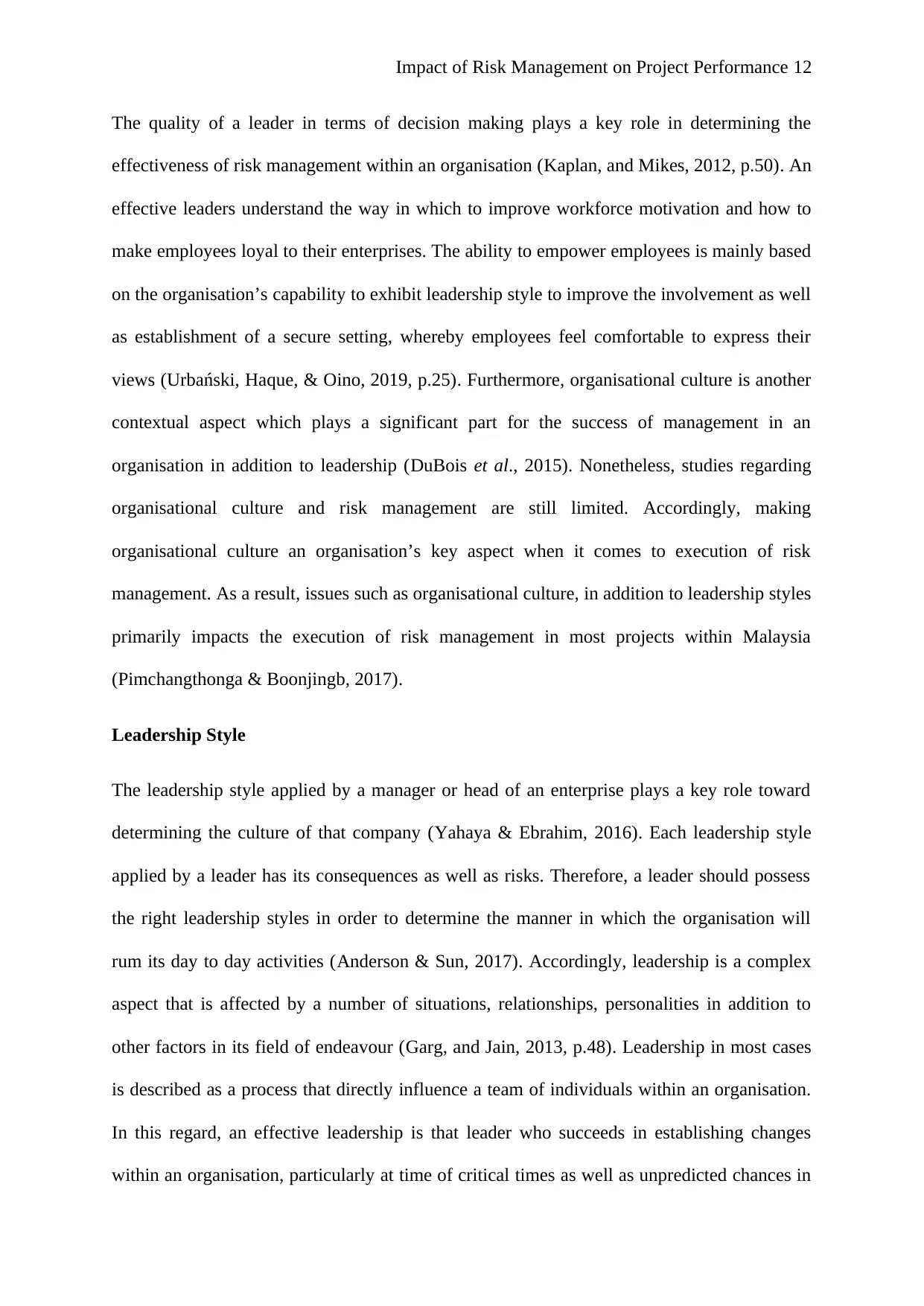
Impact of Risk Management on Project Performance 12
The quality of a leader in terms of decision making plays a key role in determining the
effectiveness of risk management within an organisation (Kaplan, and Mikes, 2012, p.50). An
effective leaders understand the way in which to improve workforce motivation and how to
make employees loyal to their enterprises. The ability to empower employees is mainly based
on the organisation’s capability to exhibit leadership style to improve the involvement as well
as establishment of a secure setting, whereby employees feel comfortable to express their
views (Urbański, Haque, & Oino, 2019, p.25). Furthermore, organisational culture is another
contextual aspect which plays a significant part for the success of management in an
organisation in addition to leadership (DuBois et al., 2015). Nonetheless, studies regarding
organisational culture and risk management are still limited. Accordingly, making
organisational culture an organisation’s key aspect when it comes to execution of risk
management. As a result, issues such as organisational culture, in addition to leadership styles
primarily impacts the execution of risk management in most projects within Malaysia
(Pimchangthonga & Boonjingb, 2017).
Leadership Style
The leadership style applied by a manager or head of an enterprise plays a key role toward
determining the culture of that company (Yahaya & Ebrahim, 2016). Each leadership style
applied by a leader has its consequences as well as risks. Therefore, a leader should possess
the right leadership styles in order to determine the manner in which the organisation will
rum its day to day activities (Anderson & Sun, 2017). Accordingly, leadership is a complex
aspect that is affected by a number of situations, relationships, personalities in addition to
other factors in its field of endeavour (Garg, and Jain, 2013, p.48). Leadership in most cases
is described as a process that directly influence a team of individuals within an organisation.
In this regard, an effective leadership is that leader who succeeds in establishing changes
within an organisation, particularly at time of critical times as well as unpredicted chances in
The quality of a leader in terms of decision making plays a key role in determining the
effectiveness of risk management within an organisation (Kaplan, and Mikes, 2012, p.50). An
effective leaders understand the way in which to improve workforce motivation and how to
make employees loyal to their enterprises. The ability to empower employees is mainly based
on the organisation’s capability to exhibit leadership style to improve the involvement as well
as establishment of a secure setting, whereby employees feel comfortable to express their
views (Urbański, Haque, & Oino, 2019, p.25). Furthermore, organisational culture is another
contextual aspect which plays a significant part for the success of management in an
organisation in addition to leadership (DuBois et al., 2015). Nonetheless, studies regarding
organisational culture and risk management are still limited. Accordingly, making
organisational culture an organisation’s key aspect when it comes to execution of risk
management. As a result, issues such as organisational culture, in addition to leadership styles
primarily impacts the execution of risk management in most projects within Malaysia
(Pimchangthonga & Boonjingb, 2017).
Leadership Style
The leadership style applied by a manager or head of an enterprise plays a key role toward
determining the culture of that company (Yahaya & Ebrahim, 2016). Each leadership style
applied by a leader has its consequences as well as risks. Therefore, a leader should possess
the right leadership styles in order to determine the manner in which the organisation will
rum its day to day activities (Anderson & Sun, 2017). Accordingly, leadership is a complex
aspect that is affected by a number of situations, relationships, personalities in addition to
other factors in its field of endeavour (Garg, and Jain, 2013, p.48). Leadership in most cases
is described as a process that directly influence a team of individuals within an organisation.
In this regard, an effective leadership is that leader who succeeds in establishing changes
within an organisation, particularly at time of critical times as well as unpredicted chances in
⊘ This is a preview!⊘
Do you want full access?
Subscribe today to unlock all pages.

Trusted by 1+ million students worldwide
1 out of 125
Related Documents
Your All-in-One AI-Powered Toolkit for Academic Success.
+13062052269
info@desklib.com
Available 24*7 on WhatsApp / Email
![[object Object]](/_next/static/media/star-bottom.7253800d.svg)
Unlock your academic potential
Copyright © 2020–2025 A2Z Services. All Rights Reserved. Developed and managed by ZUCOL.




